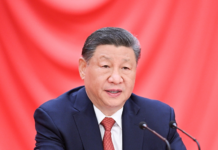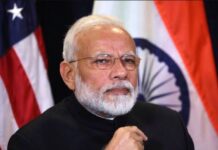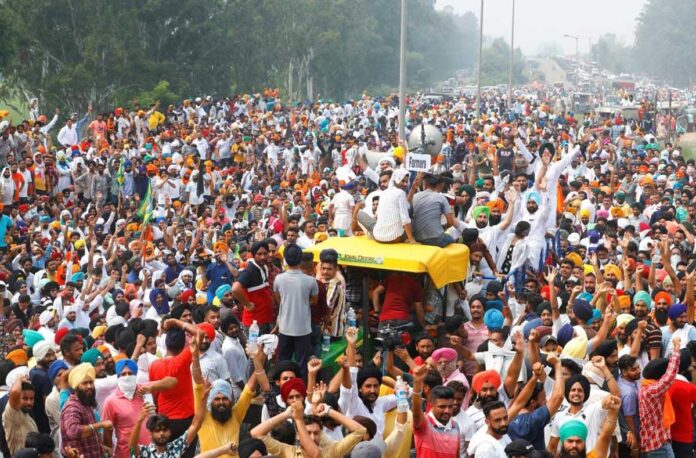The farmer’s protest in India began initially with the sole aim of getting the new farm laws repealed. The disputed laws were the Farmers’ Produce Trade and Commerce (Promotion and Facilitation) Act, 2020; the Farmers Empowerment and Protection Agreement on Price Assurance and Farm Services Act 2020 and the Essential Commodities (Amendment) Act, 2020.
The farmers perceived these laws as a surreptitious and predatory attempt by ‘crony capitalism’ to take away their lands, their single source of livelihood. But the government, infatuated by the hubris of its parliamentary majority, shrugged off the farmers’ demand.
It thought that the farmers lacked the capacity to mobilize their minuscule protest into a mass movement. Surprisingly, the farmers across several states, irrespective of their religious beliefs, joined the protest, braving police baton charges and water torrents on elderly farmers, besides inclement weather, sometimes becoming freezing. Farmers’ local and deiaspora sympathizers flooded them with food, fruit and even quintals of American almonds (from US-based toot brethren). The government is trying tooth and nail to sow seeds of discord among the Kisan unions. Formidable Jat Kisan leader, Rakesh Tikait, now on hunger strike, declared to continue the strike until his death.
The frustrated Punjabi dalits tried to seek upward social mobility through religious conversion to a different sikh dharma, Ravidassia Dharma. This dharma was formally announced by Babu Mangu Ram Mugowalia in a declaration made by the Sants of Dera Sachkhand Balan on 30January 2010
To express solidarity with the farmers, 18 opposition parties decided to boycott the Indian president’s address (29 January 2021) to a joint sitting of the parliament at the start of the budget session. They criticized the government for obduracy when 155 farmers, braving water cannons, tear gas and lathi charges, had already lost their lives. The government-sponsored media published stories that the movement was being backed up by Khalistani and Pakistani elements. Pakistani drones allegedly dropped hand-grenades in East Punjab which eerily never exploded nor were displayed to the media. The government even stooped to filing an affidavit in the Supreme Court to affirm its allegation of foreign aid to the peace movement.
The protest went on showing singular interfaith harmony where the non-Muslim human shields protected ed the Muslims offering prayers.
To `strongman’ Modi’s chagrin, the protest assumed an all-Indian dimension as Bhim Army chief Chandra Shekhar Azad, founder of Azad Samaj party (open-society party) joined the protesters with the declaration `ek juth ho kar larna hai’ we have to fight united).
Soon Azad’s harangues became viral on social media. He taunted the government that it prevented the peaceful farmers from reaching Delhi, but it could not stop the Chinese from building 110 houses in the Indian state of Arunachal Pradesh. The media blacked out pictures of farmers’ martyrs including the Sikh sants (saints) who committed suicides to express solidarity with the protesters.
It was a nightmare for Narendra Modi to observe people from all walks of life joining the movement. The 41.73 percent “oppressed-people” wave appeared to have turned against him (Muslim 14.23 percent, Christians 2.3 percent, the Scheduled castes 16.6 percent, and Scheduled Tribes 8.6 percent).Modi’s fears were unfounded. Despite rhetoric, the protesters could not turn their movement into a future-electoral alliance.
The caste factor militated against THE unity of lower castes with the upper castes. Even Sikhs have an iron-clad caste structure. Besides the caste hierarchy, religions, languages and cultures put people poles apart. India’s 1.3 billion populations (2014) includes Hindus (80 percent, including those who eat beef), Muslims 11 percent, Sikhs, Buddhists, Jains, Christians, Parsis and Jews seven per cent (combined). Hindi language is not used in Dravidian South India and though it dominates in Indo-European North India, besides 780 minor languages and dialects.
Most of the protesting farmers hailed from the Indian state of the Punjab or adjoin states. The Sikhs are believed to be the most liberal community in India. Yet, even they, like Muslims are not immune from caste influence (Muslims divide themselves into arzal, ashraf ajlaf, and so on).
Brahmins (priests) are regarded as custodians of religious Hindu traditions in the whole of India. But, this is not the case in Punjab. They are pejoratively called mang khani jaat (a community or caste living simply on alms). But degradation of the traditional Brahmans does not signify the elimination of the Sikh caste hierarchy. Caste-based discrimination in the Punjab has a different complexion. The Sikh community replaced Brahmins with affluent Jat Sikhs with material strength possessing agricultural land as and enjoying hegemony over gurdwaras and other panths (Sikh holy organizations and institutions).
Dalits who convert to Sikhism are disappointed. They are excluded from the management of committees and gurdwaras. The landowning Sikhs dominate landless dalits (untouchables).
Besides, under the local customary scheme of patron-client relationship popularly known as razat nama, they are even denied ownership rights to the plots of land on which they had built houses in segregated colonies in vicinity of the mainstream villages.
Dalits are the second largest community in the Punjab state. Numerically, they are almost equal to the strength of the Jat Sikhs. Yet, their share in the landholdings is just 4.82 percent. And they occupy only 2.34 per cent of the total area under cultivation. Being landless, dalits are denied their due share in management committees of sikh gurdwaras (shrines).
The frustrated Punjabi dalits tried to seek upward social mobility through religious conversion to a different sikh dharma, Ravidassia Dharma. This dharma was formally announced by Babu Mangu Ram Mugowalia in a declaration made by the Sants of Dera Sachkhand Balan on 30January 2010.
The pre-partition Ad Dharam movement has its roots in this dharma. This movement is the only movement of its kind in the Northwestern region of India that aimed at securing a dignified place for dalits through religious reformation, cultural transformation and political clout rather than seeking emancipation through conversion and sanskritization.
Dalits regard Guru Ravidas as their saviour. His teachings exhort dalits to stand up for themselves.
The exclusion of dalits in the Sikh caste system obstructed amalgamation of Sikhs with dalits and other minorities to shape an oppressed people’s joint movement in Indian Punjab. It also halted the conversion of he farmer’s movement.























